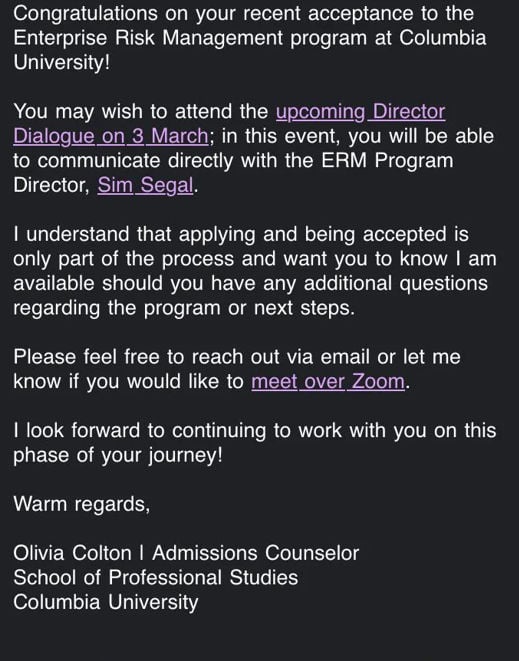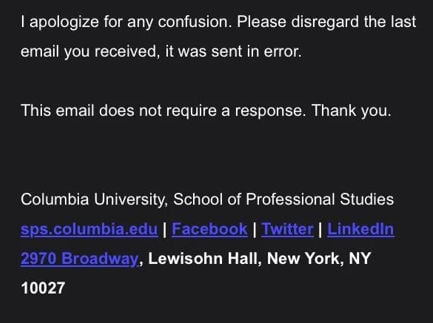Have you recently received an email claiming you were accepted into Columbia University’s Enterprise Risk Management (ERM) program? If so, you’re not alone. Many people received this email—even those who never applied—leading to confusion and concern about whether it was a scam or a legitimate communication.
This article will break down what happened, whether the email was real, and what to do if you received it.

What Was in the Email?
The email, sent from an official-looking Columbia University School of Professional Studies (SPS) address, congratulated recipients on their acceptance to the Enterprise Risk Management (ERM) program. It included:
- A greeting from an admissions counselor, Olivia Colton
- An invitation to attend an upcoming Director Dialogue event
- A mention of Sim Segal, the program director
- An offer to discuss the next steps via email or Zoom
For those who had actually applied to the program, this email would seem like fantastic news. However, many recipients never applied to Columbia, making the email highly suspicious.
Was It a Scam?
Given the circumstances, recipients immediately had concerns. Some common scam warning signs include:
✔ Unsolicited Acceptance Letters – Universities don’t usually admit students who never applied.
✔ Phishing Attempt Suspicions – The email asked recipients to engage via Zoom, raising concerns about scammers collecting personal information.
✔ Data Leak or Fraud Concerns – Some worried their personal data had been compromised.
However, this was not a scam. Instead, it was an internal mistake from Columbia University.
Columbia University’s Response
Shortly after sending the acceptance email, Columbia University sent a follow-up email stating:
“I apologize for any confusion. Please disregard the last email you received, it was sent in error.”
This confirms that the original email was not a phishing attempt or scam, but rather an internal mistake—likely caused by an email list or database error.

Why Did This Happen?
There are several possible explanations for this mistake:
🔹 Technical Glitch – A system error may have caused the acceptance emails to be sent to unintended recipients.
🔹 Database Issue – Columbia University likely has a database of past applicants, event attendees, and inquiries. An error in filtering the mailing list could have resulted in the wrong people receiving the email.
🔹 Marketing Misfire? – Some speculated that it was a strategy to generate interest in the ERM program, but given Columbia’s response, this seems unlikely.
What Should You Do if You Received This Email?
If you received this email but never applied to Columbia University, here’s what you should do:
✅ Ignore It – Columbia has already stated that it was sent in error.
✅ Do Not Respond – There’s no need to reply or engage with the email.
✅ Double-Check Email Details – If you applied to Columbia, confirm your status through their official portal.
✅ Stay Alert for Scams – Even though this email was legitimate, similar tactics are often used by scammers. Never provide personal details unless you are sure of the sender.
Conclusion
If you received an email about your “acceptance” into Columbia University’s Enterprise Risk Management program, rest assured—it was not a scam, just a mistake from their admissions team. While it may have caused unnecessary excitement or confusion, there’s no action required on your part.
This situation serves as a reminder to always verify unexpected emails—especially those involving university admissions, financial aid, or job offers. If you ever have doubts, contacting the institution directly is the best approach.










